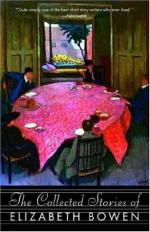|
This section contains 5,217 words (approx. 18 pages at 300 words per page) |

|
SOURCE: Brothers, Barbara. “Pattern and Void: Bowen's Irish Landscapes and The Heat of the Day.” Mosaic 12, no. 3 (spring 1979): 129-38.
In the following essay, Brothers explores Bowen's use of Irish settings in her post World War II writing, particularly her autobiographical work and the 1949 novel The Heat of the Day.
The Last September was the only one of Elizabeth Bowen's works, fiction or non-fiction, written prior to World War II that extensively drew on or reflected the life Bowen had known in Ireland.1 The preface in which she relates the importance of that life to her as a person and as a writer, however, was not written until 1952. Why is it then that after World War II Bowen felt the need to make explicit her claims to that life, claims that are reiterated in her autobiographical reminiscences—Bowen's Court (1942), Seven Winters (1942), The Shelbourne (1951), and Afterthought (1962)? The Heat of the...
|
This section contains 5,217 words (approx. 18 pages at 300 words per page) |

|


